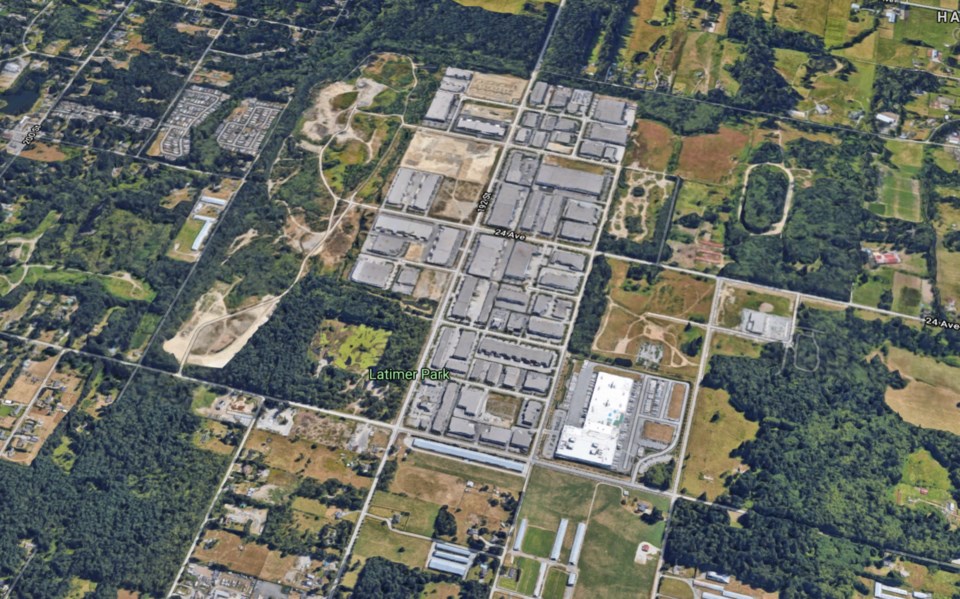The Metro Vancouver regional government has approved the City of Surrey's plan to expand industrial lands near the Surrey-Langley border, despite opposition from environmentalists and Semiahmoo First Nation.
On Friday, directors voted 69-65 in favour of changing Metro Vancouver's "urban containment boundary" so Surrey could build its 245-hectare South Campbell Heights industrial park.
The proposal was narrowly deferred on Jan. 28 with most directors requesting Surrey better consult with Semiahmoo First Nation, which claimed inadequate consultation with the municipality.
Metro Vancouver’s CAO Jerry Dobrovolny put the regional plan amendment back on the agenda quickly, following a vote Feb. 21 by Surrey city council, which claimed to have met Semiahmoo First Nation.
On Friday, directors learned from Semiahmoo Chief Harley Chappell that there was no meaningful dialogue on the matter.
“To this time, in the term of the present mayor and council, we have had one, one singular council-to-council meeting. I have had two separate meetings with the mayor but other than that we’ve had no intergovernmental relationships,” said Chappell.
“I heard this relationship was much more than it is,” he added, in an apparent reference to Surrey Mayor Doug McCallum’s insistence proper consultation had occurred.
“I implore the Metro Vancouver board to refuse this application,” said Chappell.
At issue is the fact the development will run alongside Little Campbell River, which flows into Semiahmoo Bay, where the nation lives and fishes for salmon.
Local scientists and environmentalists argued paving over the greenspace will cause not just pollution but unnaturally high stream flows that will threaten baby salmon and create a higher risk of floods at the bay, especially as stronger storms appear to be more frequent from a changing climate in B.C. Many pointed out that by removing the green space it also creates higher urban temperatures during heat waves (67 Surrey residents died in the unprecedented 2021 “heat dome”). The proposed development also sits atop a large aquifer serving homes in the region.
Ken Ashley, head of the BCIT Rivers Institute, described it as “ethically irresponsible to approve” the boundary amendment.
McCallum and his majority five on council claim the proposal brings 20,000 jobs and $20 million in tax revenue.
McCallum’s council colleagues called for the board to respect the independence of their municipality, prompting philosophical debate about the scope of regional governance.
McCallum opposed the project before becoming mayor in 2018, when it was last pitched unsuccessfully by the city. He has since explained that the development is more scaled back, including setbacks from the river three times greater than previously proposed and no housing on the site.
The land has long been planned for industrial development but has required regional approval as it was in the urban containment boundary, which is designed to contain urban sprawl.
Many opponents have pointed out the land is remote and the area lacks adequate transit access.
The vote hit at the root of Indigenous reconciliation.
Semiahmoo councillor Joanne Charles pointed out what she views as a systemic problem at the Metro board level: “We’ve been identified as a ‘stakeholder’ but we are a First Nation. We should not be considered a stakeholder. Unfortunately, due to some of the policies and procedures and processes that are involved, that’s the only place we get lumped in because there is no recognition as a First Nation. We get lumped into being stakeholders... and that needs to change.”
Directors who opposed the project on environmental grounds expressed confusion over how the proposal got back on the agenda.
“I have to ask myself, how did this application even get to the board?” asked director and North Vancouver Coun. Lisa Muri.
Surrey councillor Linda Annis led the deferral process last month and on Friday she voted against the project because of a lack of consultation.
“As much as I support development and jobs, I also support transparency and hearing what residents have to say, even if it’s not what we want to hear,” said Annis, who claims significant local opposition to Campbell Heights.
“This is a Surrey issue and it’s unfortunate... when our voters are ignored and sidelined,” she said.
Surrey Coun. Laurie Guerra noted Metro Vancouver staff recommended the project (more specifically, the amendment to contract the urban containment boundary).
Guerra joined councillors Allison Patton, Mandeep Nagra and Doug Elford alongside McCallum to form a large chunk of the weighted vote in favour.
Also voting in favour, among mayors or others with four, or the maximum five points, were Delta Mayor George Harvie, Port Coquitlam Mayor Brad West, Coquitlam Mayor Richard Stewart, Township of Langley Mayor Jack Froese, Metro chair and Burnaby councillor Sav Dhaliwal, Burnaby councillor Pietro Calendino and Vancouver councillors Melissa De Genova and Lisa Dominato.



